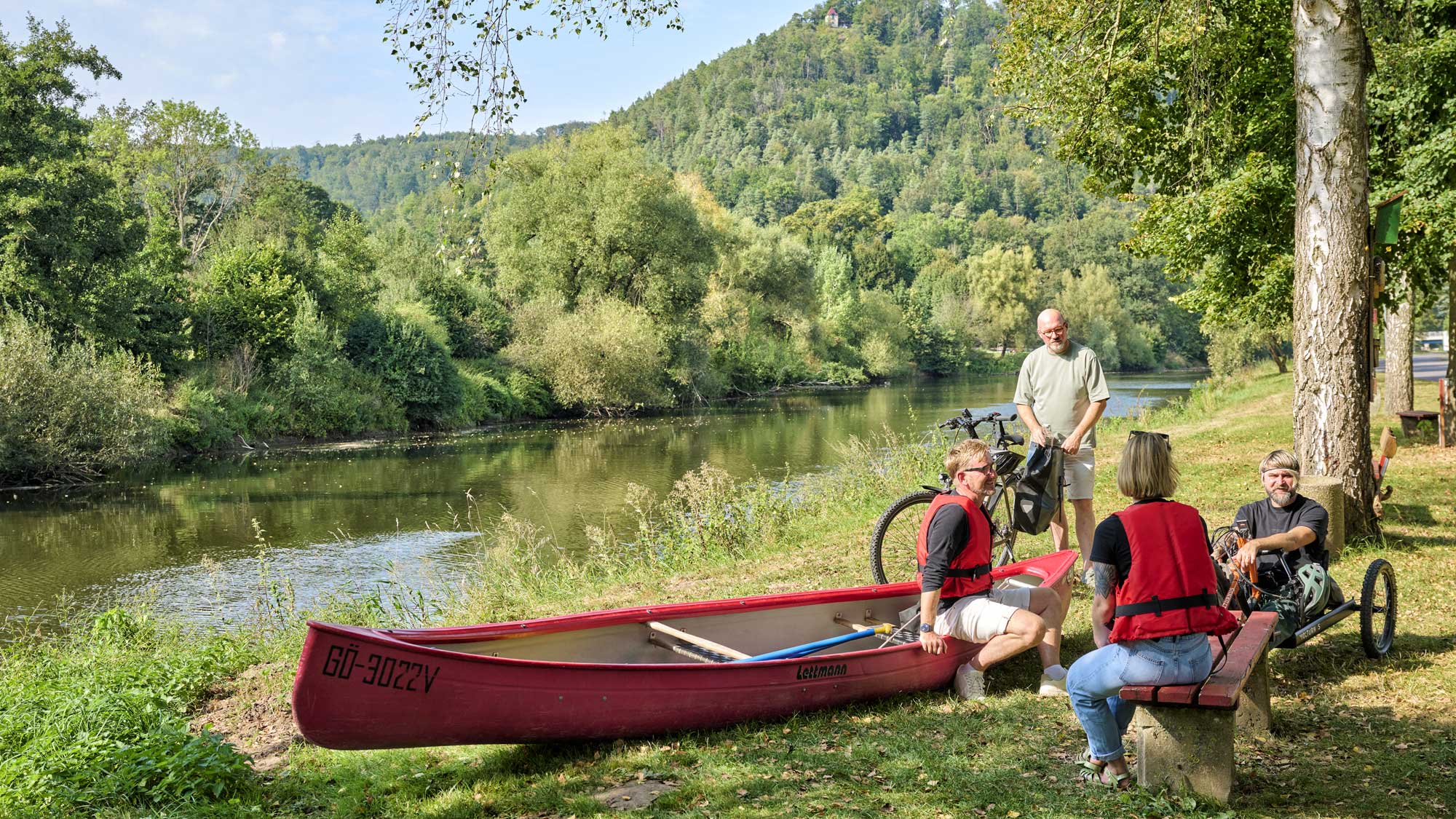You're in the right place! Whether in nature, in the middle of the city, for families, in the countryside, historic or traditional: among Thuringia's TOP hosts, everyone will find exactly the right address.
A Gothic stage for medieval prominence
St. Mary’s Museum and Müntzer Memorial
The imposing St. Mary’s Church is embedded between listed buildings in Mühlhausen’s old town. It is the second largest church in Thuringia and the largest five-nave church in the state. Nowadays, the secularised church building is used as St. Mary’s Museum for exhibitions and as a memorial to Thomas Müntzer. Construction of the Gothic masterpiece began in the 14th century. Travertine, the light-coloured limestone of the region, which was partly quarried in Mühlhausen itself, was used for the construction. The influences of French cathedral building are unmistakeable – in spite of the remains of the earlier Romanesque church which can still be seen at the bottom of one of the towers.
A birthday present for everyone
The stained glass windows inside the St. Mary’s Museum fascinate visitors. Some date back to the 14th century, whilst others are the result of a fund-raising campaign in 1887 to mark the 90th birthday of the King of Prussia and first Emperor of Germany, Wilhelm I. A valuable altar dedicated to St. Mary has impressed visitors to the building since the 17th century.
Prominent patronage for exhibits of the current special exhibition
The St. Mary’s Museum in the main section of the former church is perfect for exploring on your own. It currently houses a special collection of more than 60 objects of late medieval art from Thuringia, Saxony and Franconia – all of which are loaned by the foundation Klassik Stiftung Weimar. The collection includes extraordinary altars, sculptures and stained glass windows featuring Christ, Mary and other Christian saints. Typical of this era: unicorns and dragons appear in many places in the compositions. Do you have a special feeling as you examine the exhibits? This might be because the poet and political Johann Wolfgang von Goethe recognised the material and intangible value of these artworks and was a joint founder of the collection.
Brief colour lexicon
From the life of Thomas Müntzer
The aura of the theologian Thomas Müntzer, who also lived opposite St. Mary’s Church, can still be felt in the building – it was from the pulpit of this church that he proclaimed his powerful sermons in favour of greater “freiheyt” (freedom) in the sixth century. Some of them became key speeches in the lead-up to the battle in Bad Frankenhausen during the German Peasants’ War of 1525. His varied life is projected onto the old stone floor. In a niche, the expressive sculptures created by the sculptor and painter Klaus-Michael Stephan show the radical Reformer streaming with blood, suffering, writhing … They are amongst the outstanding works of art in Mühlhausen’s museums. They are a significant piece of art history, but are also fascinating from the perspective of cultural and institutional history.
Can you see me?
No original object belonging to Thomas Müntzer is preserved. In the former sacristy, however, various objects featuring his image are exhibited, including medallions, beer tankards and banknotes – or at least with an idea of what he looked like because no portrait of him exists. He was greatly revered in East Germany, and the museum also shows that the art scene there used him as a subject. When you enter the room, you will immediately notice the rainbow flag. With a similar version, Thomas Müntzer led hundreds of rebels into battle in Bad Frankenhausen on 15 May 1525 – he saw a rainbow that suddenly appeared in the sky there as a sign of the legitimacy of the armed revolt. However, they were defeated and only around a quarter of them survived. The radical Reformer was subsequently executed. Historians regard the uprising as one of the most traumatic events of the early modern era.
Tower life
Step into another exciting part of the St. Mary’s Museum … The imposing church building as you see it today was completed at the beginning of the 15th century – apart from the west tower. It was not until 1895 that the parish began to extend the tower, which had never quite been completed, until it was the highest church tower in Thuringia at just under 87 metres. A guided tour is highly recommended! Your visit will begin with an exhibition on the construction of the tower. Interesting fact: each stone was engraved with the individual rune-like mark of the respective stone mason. This made calculating the wages easier. Some of these symbols are represented graphically. Amusing anecdotes are used to show how watchmen lived in Mühlhausen. A screen has also been set up – watch what is currently happening in the falcon incubators live. With luck, you will be able to see fluffy chicks.
Exciting ascent through the centuries to the Holy Spirit hole
It is wonderfully quiet up in the attic above the central nave. In the early modern era, this area was fitted out with wooden walkways because the floor contains a number of surprises: Holy Spirit holes are set into it and are only covered by a wooden lid. In the past, this was removed on religious festivals so that figures could be lowered into the church or pulled up, for example on Ascension Day. One floor lower, there is an accessible balcony. There is a stirring view from here over the old town surrounded by the medieval city walls. You are sure to marvel at the clock mechanism in the tower as well as at the oldest of the three bells – it has been in use for more than 530 years and weighs around 5.5 tonnes. “Cast from bronze,” the guide explains, “because this material makes the best sound.”
A protective Mary, demonic gargoyles and an emperor made of stone
The external façade tells visitors to Mühlhausen a story of its own, which is closely interwoven with the city’s history as an Imperial City. The sovereign should have been present to swear in the council, which changed every year. As this was not possible for him, sculptures of Emperor Charles IV, who ruled from 1355 to 1378 and was very involved in politics, his wife and some courtiers were placed on the balcony over the south portal. They are leaning towards the people who come through the portal, which is to be understood as a gesture of approval. Biblical figures, including Maria, the patron saint of this church, adorn the former main entrance. In 1525, the year of the German Peasants’ War, an angry crowd destroyed the stone figures right on the portal in a blind rage. It was not rebuilt until much later.
Designed in the form of demons and animals, the gargoyles in the upper sections of the external façade of St. Mary’s Church produce a fascinating and slightly terrifying appearance effect. They symbolised the influence of the devil on the earthly world or were supposed to keep evil spirits and other dark forces away with their terrible appearance. Superficially, however, they had a practical function: they were able to drain off rainwater without any problems.
Johann Sebastian Bach’s cantata for the inauguration of a new city council
When he was young, the world-famous composer and musician came to Mühlhausen for a year as an organist. At the age of 23, he composed a cantata for the inauguration of the newly elected city council in 1708. “Gott is mein König” (God is my King) was the only one of his compositions to be published in printed form in his lifetime. If you cannot remember this stirring piece of music (anymore), you can listen to it at an audio station outside the south portal.
In the State Exhibition, the progressive phases of the German Peasants’ War will be shown from a transregional perspective. Part of it is to be presented in the St. Mary’s Museum in 2025. The former St. Mary’s Church is one of the four succinct stops relating to this subject in the medieval Imperial City of Mühlhausen. The radical Reformer Thomas Müntzer preached here. The thematic walking tour also starts in this building: engage in the story of the peasants of the early modern era in the St. Mary’s Museum | Müntzer Memorial and find out how the cycles of the farming year were connected to the uprisings for their freedom. In the context of the Thuringian State Exhibition 2025, the next stop in Mühlhausen is: the Peasants’ War Museum in the Corn Market Church, another exciting original location!
Header Picture: ©Florian Trykowski, Thüringer Tourismus GmbH
Accessibility
Did you like this story?
Visitors' information
Angebote
Booking
You might also be interested in ...












